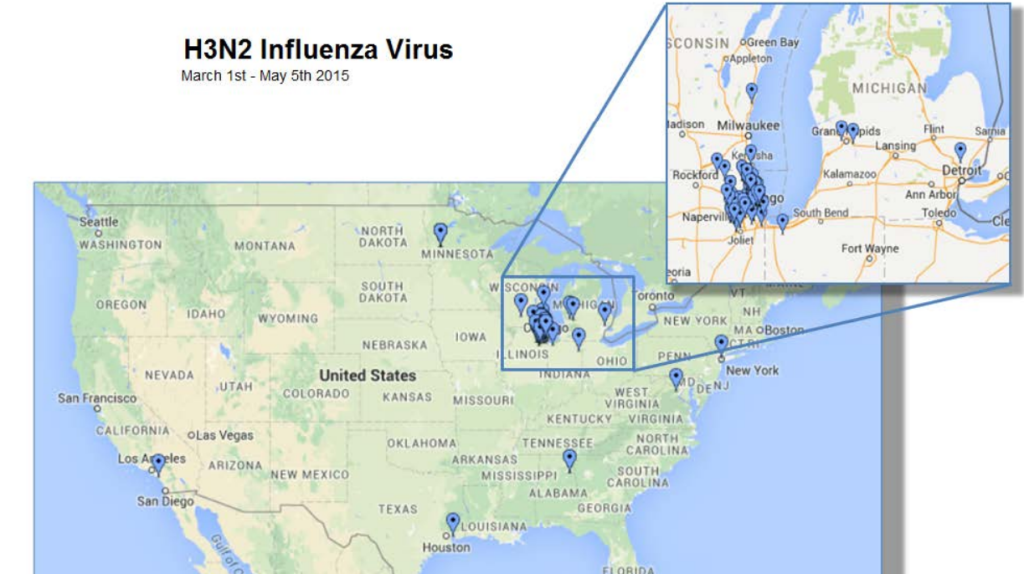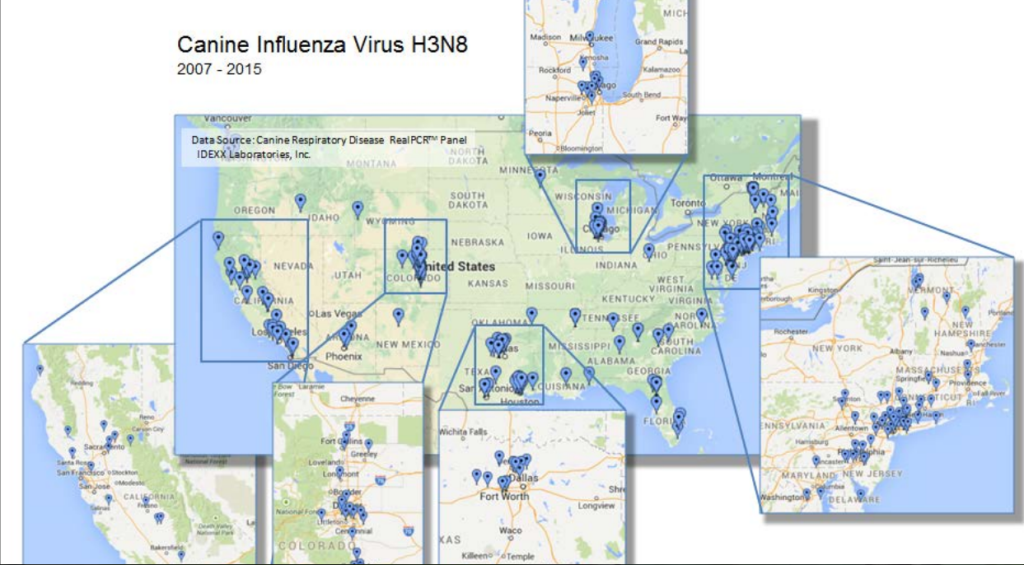Canine Influenza Virus Reported in Minnesota | Dr. Justine Lee
Take your dog to Minnehaha dog park in Minneapolis? Worried about Canine Influenza Virus? This blog is must-read for all MN dog lovers!
Any dog owner living in the Midwest right now is aware of the potential dangers of Canine Influenza virus (CIV) after a massive outbreak that started in Chicago in early spring 2015. Since then, pet owners and veterinarians have been carefully monitoring to see what other states are affected, so they know how to protect their pets and patients.
Since the outbreak in April of 2015, the following additional states have been affected with CIV H3N2:
- Illinois
- Wisconsin
- Iowa
- Texas
- New York
- Michigan
- California
- Indiana
Just last month, the newest strain of CIV H3N2 was reported in Minnesota. Why I care? Because I practice in the Twin Cities and take my dog to several Minneapolis dog parks… and I don’t want my dog to get sick!
Back in mid-April, there were reports that a single boarding facility in Detroit Lakes, MN had a dog come through that had traveled to Chicago. A group of dogs were exposed to that dog, and they became sick with clinical signs consistent with canine infectious respiratory disease (CIRD). Tests were done and sent to Idexx laboratories that that time, but the test wasn’t available (for H3N2) at that time. Since then, Idexx has released a H3N2 test. In the meantime, those dogs recovered with therapy and supportive care.
These dogs ended up testing positive for multiple infectious diseases from CIRD; they were positive for H3N2, Bordatella, and Pasturella. What does this mean? It means that we have it in the state of Minnesota and should proceed with caution.
To see the original map tracking by Idexx, view it here.
CIV is highly infectious and can be potentially but rarely, be fatal. A similar virus, H3N8 was first isolated in 2004 in Florida at a Greyhound racing track. Since then, the original virus, H3N8, has been seen in multiple states (approximately 40 states and counting – see the map below).
This newer, mutated virus, H3N2, has resulted in a major outbreak as most dogs are susceptible to this influenza virus as they haven’t built up immunity to it. Thankfully, it’s not contagious to humans, although there are reports that this Asian (Korean) H3N2 virus can spread to cats.
Keep in mind that Canine Influenza virus is not the same thing as Bordatella brochiseptica (which is more commonly known as Kennel Cough). That said, both infections can be spread the same way: by transmission through direct contact with respiratory discharge from infected dogs (e.g., contact with the nasal discharge, etc.); by air through sneezing, barking, coughing; or by exposure to contaminated objects (e.g., such as dog bowls, cages, clothing, etc.)
Depending on the severity of the infection, Canine Influenza can result in in severe damage to the lungs along with secondary pneumonia. Due to the rapid ability for CIV to spread, it’s estimated that up to 20% of dogs can develop severe pneumonia as a result. Clinical signs of CIV can be seen in less than 5 days after infection.
So what signs should you monitor your dog for?
- Coughing
- Excessive panting
- Exercise intolerance
- Discharge from the nose
- Not eating
- Lethargy
- Fever
- Difficulty breathing
- Blue-tinged gums
- Lung failure (e.g., acute respiratory distress syndrome)
- Death
If your dog shows any of these clinical signs, first make sure not to bring your dog to any area where he or she is exposed to other pets. No dog parks, doggy day cares, etc. Otherwise you will earn and get very, very bad pet karma from this veterinarian for the rest of your life. Seriously.
Next, make sure to contact your veterinarian immediately. That’s because a thorough exam, temperature, and blood work and/or x-rays should be done. If your dog is having difficulty breathing, get to your emergency veterinarian – even if it’s in the middle of the night! Thankfully, there is a test for CIV – your veterinarian can send swabs from the nose and pharynx (upper airway/mouth) directly to Cornell University’s Veterinary Diagnostic Laboratory or Idexx.
Here, some tips about bringing your dog to the veterinarian:
- If you’re going to your family veterinarian, ideally, your dog should be seen as one of the later appointments in the day to prevent exposure to other dogs.
- If your dog is showing clinical signs, your dog should be taken immediately back into an examination room instead of potentially exposing other dogs in the waiting room.
- If your dog requires hospitalization, it will require isolation in a separate area of the veterinary clinic to prevent spreading the infection to other dogs. (Even the air supply to the isolated area should be separated by a door, wall or separate ventilation system to prevent transmission through the hospital).
- When hospital staff handle a dog with CIV, they should use gloves and a gown to prevent cross-contamination to other patients. When exiting the isolation room, shoes should be disinfected (with a footbath) to prevent spread of CIV through the hospital.
- Staff should thoroughly wash their hands with soap and water or use an alcohol-based hand sanitizer after handling infected dogs.
Thankfully, traditional veterinary disinfectants can kill Canine Influenza virus easily with appropriate hygiene, isolation, and sanitation procedures.
Blood work and x-rays should be done to assess the white blood cell count, oxygen level, and severity of pneumonia in the lungs. Treatment for mildly affected dogs with CIV may range from isolation from other dogs (for at least 2 weeks), and a course of antibiotics and anti-cough medication (only after x-rays have been done). For dogs that are more severely affected that require hospitalization, additional therapy may include:
- Oxygen therapy
- IV fluids to help keep your dog hydrated
- IV antibiotics
- Nutritional support
- Anti-vomiting medication if needed
- Isolation from other dogs for at least 2 weeks
As a result of this outbreak, pet owners should avoid these areas until more the outbreak ceases:
- Doggy day cares
- Dog parks
- Kennels
- City streets with high exposure to other dogs
- Dog shows
- Grooming facilities
- Vaccine clinics
- Pet stores
Is there any thing I can do to protect my dog?
For those Minnesotan pet owners, the outbreak was seen in Northern MN, so I don’t think we have anything to fear immediately; however, talk to your veterinarian about how to best protect your dog with vaccines.
Thankfully, there is a vaccine for the older type of Canine Influenza (Nobivac® Canine Flu H3N8, Merck Animal Health and Vanguard CIV, Zoetis). The vaccine has been shown to protect dogs against CIV infection for H3N8 by significantly decreasing clinical signs, reducing viral shedding, and reducing the severity of damage to the lungs. Just like other vaccines, this vaccine needs a booster 2-4 weeks after the first dose (Remember, just one dose is not effective alone, as the body needs to respond to the second vaccine to stimulate the immune system).
Most importantly, know that this vaccine is for H3N8, not for H3N2. Hopefully there is some cross protection (just like the way flu vaccines work in humans), but studies are still underway.
Some of this content was previously published by www.pethealthnetwork.com




No Comments
Trackbacks/Pingbacks